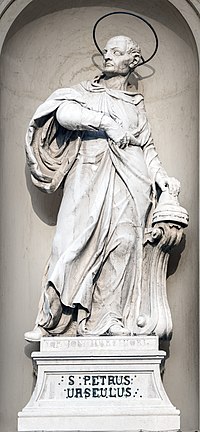Pietro I Orseolo
| St. Pietro Orseolo, O.S.B. Cam. | |
|---|---|

|
|
| Doge | |
| Born | 928 Udine, Republic of Venice |
| Died | 10 January 987 Cuxa, County of Conflent |
| Venerated in |
Roman Catholic Church (Patriarchate of Venice & Camaldolese Order) |
| Beatified | 1027 by Arnulf |
| Canonized | 1731, Rome, Papal States, by Pope Clement XII |
| Major shrine | Prades, Pyrénées-Orientales, France |
| Feast | 10 January; 14 January (Pre 1969), 19 January (Camaldolese) |
Pietro I Orseolo, O.S.B. Cam. (Peter Urseolus) (928–987) was the Doge of Venice from 976 until 978. He abdicated his office and left in the middle of the night to become a monk. He later entered the Camaldolese Order. He is venerated as a saint in the Roman Catholic Church following his canonization in 1731.
Orseolo was born in 928 near Udine to one of the more powerful families in Venice: the Orseolo who were the descendants of Teodato Ipato and Orso Ipato. At the age of 20 he was named commander of the Venetian fleet, performing distinguished service as a soldier; he waged successful campaigns against the Dalmatian pirates. He was also devoted to the Roman Catholic Church.
In 976, the sitting doge, Pietro IV Candiano, was killed in a revolution that protested his attempts to create a monarchy. According to a statement by the Camaldolese monk and cardinal, Peter Damian, Orseolo himself had led a conspiracy against Candiano. This statement, however, cannot be verified. Nonetheless, Orseolo was elected as his successor. His wife and consort was Felicia Malipiero.
As doge, Orseolo demonstrated a good deal of talent in restoring order to an unsettled Venice and showed remarkable generosity in the treatment of his predecessor's widow. He built hospitals and cared for widows, orphans and pilgrims. Out of his own resources he began the reconstruction of the ducal chapel, now St. Mark's Basilica, and the doge's palace, which had been destroyed during the revolution, along with a great part of the city. Two years later, on September 1, 978, seemingly without notifying anyone, not even his wife and children, he left Venice with Abbot Guarin and three other Venetians (one of whom was St. Romuald) to join the Benedictine (now Cistercian) abbey at Saint-Michel-de-Cuxa (Catalan: Sant Miquel de Cuixà) in Prades (Catalan: Prada), southern France.
...
Wikipedia
